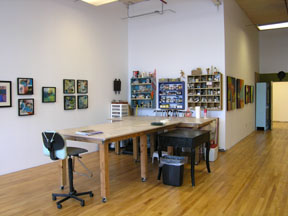 |
| "Modi" in 1909 wearing his artistic style of clothing in Paris |
Modigliani was born in 1884 in Livorno, Italy to a family of Sephardic Jews who claimed to trace their history back to the philosopher Spinoza in the 17th century. Known to his family by the nickname "Dedo", Modigliani was the fourth child in a family that struggled with poverty after a history of wealth. His mother ran a school for young children and educated Dedo at home, where he learned to read and write in both Italian and French at an early age. There are family stories about Dedo drawing continuously on every type of surface, and at age 12 his mother wrote that, "He already sees himself as an artist."
He had problems with lung diseases from his youth, and at age 15 he contracted tuberculosis. Secrest details the widespread contagion of tuberculosis and its progression in the body (in the 1850s half the population of Britain had the disease) . Tuberculosis usually first attacks the lungs and can eat away the tissue, causing bloody sputum and hemorrhages. (As we now know, it is a contagious disease that can be passed among a population - especially among young and immune-suppressed people. About one-third of the world's population is currently infected with TB, according to the World Health Organization.)
Although TB is now treated with antibiotics, at the turn of the 20th century the only cure was rest and nourishing food, preferably in an atmosphere of seabreezes or mountain air. Dedo went away with his mother to the Mediterranean coast for about six months for the rest cure, and the disease went into remission. However, the main thesis of Secrest's book is that tuberculosis came back to haunt Modigliani later in life and progressed from his lungs to other parts of his body, ultimately causing his death.
 |
| Artist in the studio - 1916 |
Modigliani moves to Paris
First continuing his art studies in Florence, Rome, Naples and Venice, Modigliani relocated to Paris in 1906, supported by some money from his mother and an allowance from an uncle. Secrest sets the scene in Paris evocatively, including the cost of bread and milk and listing the various types of workers who performed the humble tasks necessary for the city's operation.
Modigliani made friends easily and moved to the artists' quarter in Montmarte within a few months. Now known to his friends as "Modi," his studio was described by a friend as "a tumbledown shack on a treeless, ugly scrap of ground, and although it was furnished in the most spartan manner, oppressive and neglected like a beggar's hovel, one was always glad to go there for one found an artistic atmosphere in which one was never bored." And Modi and friends could be found most nights at the "combination cafe' and watering hole", the Lapin Agile.
 |
| The Lapin Agile 1880-1890 (courtesy of Wikipedia) |
 |
| The Lapin Agile 2010 (courtesy of Wikipedia) |
A Hard Life
Modigliani sold very little work during his early years in Paris and depended on loans or donations from his family to get by. He was always struggling to eat, have a place to live and get a drink. He was good looking, charming and attracted women, who sometimes let them live with them or "loaned" him money. He had an open manner and a natural sense of style that gave him an "aristocratic" air, despite his lack of funds. A longer-term benefactor was Paul Alexandre, a doctor who loved the artistic life and bought a derelict old building where he invited artists to live.
 |
| Jean Alexandre, brother of Paul, Modi's benefactor |
 |
| Portrait of Chaim Soutine, a friend of Modi's |
 |
| A Modigliani head, ca. 1910. Modi was friends with Brancusi and influenced by him and by African sculpture. |
More to Follow








4 comments:
Nancy, Modigliani was my first love...of an artist, that is. Well, he was dead by then but I found him and his life very romantic and loved his paintings. I think the first portrait I painted must have been influenced by his portraits, though not intentionally. I could call it my mannerist painting...her neck was so long. Thanks for this post. I will have to get that book. Saw some of his paintings a couple of years ago here in Houston. Fell in love with him all over again.
Thank you for another interesting post, Nancy. Great pictures too --- I especially enjoyed seeing The Lapin Agile and imagining Modigliani and his buddies passing through its door.
Years ago I was struck by a photograph that exists somewhere and still haunts me. It shows a horse and wagon stopped in a filthy street. Moigliani's paintings lean against the wheels, on the cobblestones and without protection, for transport following his eviction from his studio.
Fascinating. Thank you for sharing.
Dixie
I recently read that he was really a sculptor, but kept "loosing" his work in his frequent and hasty moves when he was kicked out of his lodgings when he couldn't pay the rent. I don't know if that's true but, it makes a good story and it's a shame (if it is true)because that head that you posted is exquisite.
Post a Comment